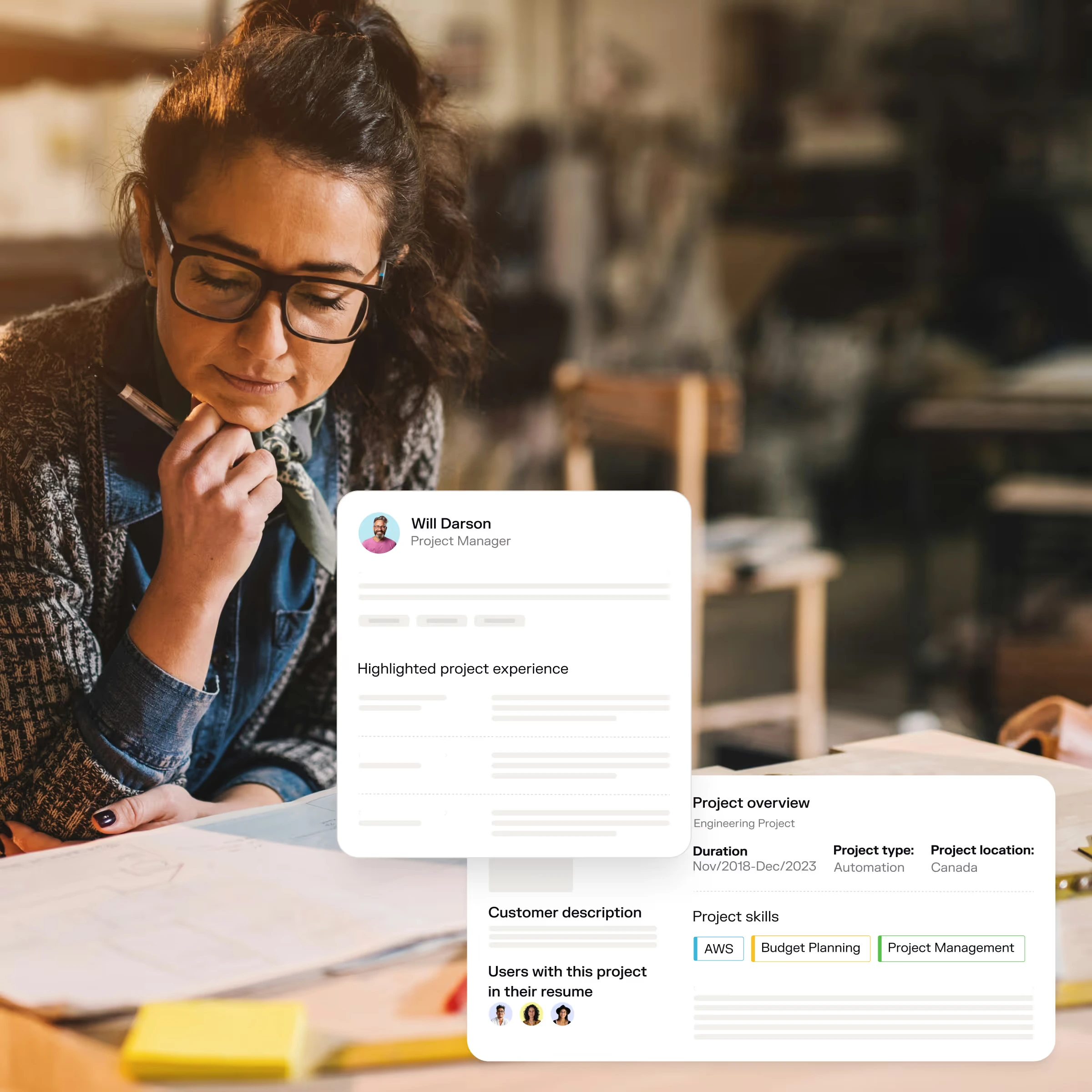When clients evaluate a construction proposal, they’re not just buying a plan, they’re buying your track record. Your ability to deliver similar projects successfully is one of the most persuasive factors in the evaluation process. That’s why the past performance section is a critical component of any construction RFP response.
In this blog, we’ll walk through how to write past performance content that builds confidence and wins work. But that’s only part of the story. We’ll also explore how you can then easily manage past performance data at scale, in order to easily find, tailor, and showcase it. Additionally, we’ll introduce tools that can turn this painful task into a strategic advantage.
First, let’s start with how to write strong past performance sections.
How to Write a Compelling Past Performance Section
When clients evaluate a construction proposal, one of the most telling indicators of future success is past performance. But that doesn’t mean just listing completed jobs. It means clearly communicating what you delivered, how you delivered it, and what made the project relevant or impressive. That’s where the Challenge–Solution–Outcome (CSO) structure comes in.
This framework gives each past performance a clear, consistent narrative. It helps proposal evaluators, who often aren’t technical experts, grasp the value of your experience quickly and confidently.
Here’s how to apply it effectively:
1. Challenge
The challenge section is where you set the stage. What was the client trying to achieve, and what made the project difficult or complex? This section should not only introduce the project, and any contextual information, but it should also frame the scale and significance of your achievement.
To write this section effectively:
- Start by describing the client’s objective or need—what did they want to build, solve, or improve?
- Identify the key constraints or risk factors: Was the site remote? Was the timeline compressed? Were there budget limitations, heritage restrictions, or complex logistics?
- Keep it focused and outcome-oriented—you're not telling the story for its own sake, but to highlight what your team was up against.
This section helps evaluators understand the context and appreciate the level of difficulty your team successfully navigated.
2. Solution
Once the challenge is clear, shift to the actions your team took to solve it. This is the core of the narrative, and where your expertise should shine through.
To structure this section:
- Describe your approach or methodology—how did your team plan and execute the project?
- Mention specific tools, processes, or innovations that were critical to success. For example, did you use BIM for clash detection? Did you sequence work in a unique way?
- Highlight the roles and responsibilities your firm held—design, engineering, construction management, subcontractor coordination, etc.
- You can also touch on team dynamics if relevant, especially when collaboration or stakeholder engagement played a key role.
This section should make it clear that your team didn't just complete the project, but that they did so in a way that demonstrated skill, creativity, and professionalism.
3. Outcome
This final section is where you show the impact of your work. The goal is to quantify and qualify the results in a way that builds credibility and trust.
Here’s what to focus on:
- Share measurable results wherever possible—did you deliver ahead of schedule, under budget, with no incidents? Include metrics like square footage, project value, or carbon savings if relevant.
- Highlight quality outcomes beyond metrics, such as stakeholder satisfaction, community benefit, or successful compliance.
- If applicable, include proof points such as client endorsements, awards, or follow-up work.
This section should answer the unspoken question: Why should we trust you to deliver this upcoming project? It's your closing argument, and it needs to be clear, concise, and results-oriented.
The Challenge–Solution–Outcome structure isn’t just useful for telling strong stories—it also makes your case studies easier to compare, tailor, and reuse across proposals. Once this structure becomes standard practice, it saves time and ensures your team always presents experience in a compelling, professional format.
How To Create Past Performance Documents For Construction Proposals
As we mentioned in the introduction, writing a strong past performance narrative is only the first step. To respond to proposals efficiently, and at scale, firms need a reliable way to manage, access, and customize those narratives as part of their broader proposal process. This section focuses on the operational side of past performance: how to organize your experience data, search for the right project examples, tailor them to each opportunity, and showcase them in the correct format. Done well, this turns past performance from a one-off writing task into a repeatable process that can be used across every bid.
Manage: Building a System for Past Performance Reuse
For most construction firms, the challenge isn’t just creating project narratives, it’s storing and structuring them in a way that makes them findable, reusable, and tailorable across proposals.
To make that possible, past performance records need to be managed systematically. That means creating a central, structured repository that supports consistency, reduces duplication, and keeps your team aligned.
Why Centralized Management Matters
At the heart of every good proposal system is organized, standardized content. Past performance data is no exception. The goal is to create a single source of truth for your firm’s experience—one that’s always up to date, structured for reuse, and accessible across teams.
When past performance records are managed centrally:
- Teams can easily locate the right projects for each bid
- Content stays consistent, regardless of who last edited it
- Updates only need to happen in one place, reducing errors
- Proposals can be built faster, with less duplication of effort
Standardize the Structure
To make past projects easy to use and reuse, they need to follow a standard structure. Each case study should include consistent sections and data points so they can be compared, searched, and exported in a repeatable way.
At a minimum, you should capture:
- Project name, location, and client
- Contract value and timeline
- Delivery method and project type
- A narrative written in the Challenge–Solution–Outcome format
- Tools, technologies, and skills used
- Outcome metrics and client satisfaction
Standardizing these fields creates the foundation for powerful filtering and dynamic reuse, which we’ll explore in the next sections.
Use a Proposal Management Platform
The best way to manage past performance is through a dedicated proposal platform that’s purpose-built for this type of content. Flowcase allows you to store, structure, and search all your case studies in one place—fully integrated with your resumes, templates, and workflows.
Rather than juggling siloed documents or spreadsheets, Flowcase gives your team a unified space where:
- Master versions of each project are maintained and updated
- Proposal-ready versions can be created without overwriting the original
- Your entire database of experience is ready to pull into any proposal
This reduces human error, ensures consistent quality, and saves hours for every bid.
Plus, Flowcase integrates with your existing ERP or CRM systems, meaning you can maintain a single source of information, while ensuring it’s easily accessible for proposal purposes.
Bonus: Connect Projects to People
One of the biggest missed opportunities in past performance management is not linking project data to the people who worked on them. In Flowcase, every case study can be connected to the individuals who contributed—making it easy to:
- Showcase project-specific contributions in resumes
- Search for team members by the projects they’ve delivered
- Automatically populate CVs with relevant experience

Tailor: Make Each Past Performance Feel Client-Specific
Even the best past performance examples lose their impact if they feel generic or recycled. Proposal evaluators want to see that you’ve done similar work and that you understand the unique context of their project. That’s why tailoring your past performance content is so important.
Of course, tailoring doesn’t mean rewriting everything from scratch. Rather, it means adapting the content strategically to match the priorities, language, and tone of the specific RFP you’re responding to.
Focus on Relevance
Start by identifying what the client cares about most in this bid. Is it schedule certainty? Sustainability? Experience in a particular building type or regulatory environment? Then, review your case study and emphasize the aspects of the project that align with those priorities.
For example:
- If the RFP emphasizes carbon reduction, highlight the sustainable elements of your past project—even if they weren’t the core focus originally.
- If the bid is for a school in a dense urban area, emphasize any similar site constraints or stakeholder coordination from your previous education-sector projects.
By drawing those parallels clearly, you help the evaluator connect the dots without having to work for it.
Adapt the Language and Tone
Mirroring the language of the RFP can go a long way in making your response feel tailored. Use the same terminology they use (e.g., “design-build,” “net-zero,” “occupant safety”), and ensure the tone matches the rest of the proposal—whether it’s highly technical, outcomes-focused, or stakeholder-sensitive. The blog below outlines some practical tips for how to achieve this, albeit in the context of CVs and resumes:
Customize Without Losing the Original
Tailoring should be fast and controlled—not a formatting mess or a versioning nightmare. That’s why Flowcase allows you to clone master case studies and adapt them for each proposal without altering the original. You can:
- Edit specific sections to emphasize relevance
- Swap in more appropriate outcome metrics
- Reframe the narrative without rewriting from scratch
The result? Content that feels like it was written just for this client—without starting from zero every time.
Showcase: Format and Export with Consistency and Confidence
Once your past performance content is written, managed, found, and tailored—it still needs to be presented professionally. While formatting past performance content is the last mile, it’s often the most frustrating. Copying content into the wrong template, dealing with inconsistent layouts, or wrestling with tables and design elements can eat up valuable hours and introduce costly errors.
That’s why having the right tools to showcase your content—quickly and consistently—is essential.
Templates: From Content to Proposal-Ready
Proposal formatting requirements vary. Some clients ask for tabular past performance summaries, others want narrative case studies, and some provide strict layouts that must be followed to the letter.
Flowcase helps you handle all of these without manual rework. With custom templates and export tools, you can:
- Instantly drop tailored content into your branded templates or client-specific formats
- Export as Word Doc, PDF, InDesign, or PowerPoint depending on submission requirements
- Ensure consistency across proposals, even when multiple team members are involved
- Eliminate time spent on manual layout, formatting, and duplication
Reduce Risk and Increase Professionalism
Formatting errors can damage first impressions—or worse, lead to non-compliance in tightly controlled RFP processes. Automating this step reduces human error, ensures you meet all formatting requirements, and allows your team to focus on refining the content, not wrestling with Word files.
With the right system in place, showcasing your past performance becomes seamless, scalable, and consistent—no matter how many proposals you're producing each month.
Here's how Templates work in practice - using the tricky SF330 as an example:
Conclusion: Streamlining Construction Past Performance
In construction proposals, past performance isn’t just a supporting section—it’s often the deciding factor. It’s how you prove that you don’t just have the capabilities—you’ve already delivered. But turning your firm’s project history into a consistent, compelling, and scalable proposal asset takes more than good writing.
To win work consistently, you need to:
- Write past performance narratives that clearly communicate challenges, solutions, and outcomes
- Manage your project data in a structured, centralized way
- Find relevant examples quickly based on what matters to each bid
- Tailor them to each opportunity so they feel specific and persuasive
- Showcase them professionally and consistently across every submission
Flowcase was built to support exactly this. It helps construction firms transform their project experience into a competitive advantage—streamlining everything from content management to final formatting, all while maintaining quality and consistency.
If you’d like to learn more about Flowcase, book a personalized demo here.
FAQs About Past Performance for Construction Proposals
What is the best framework for writing a past performance section?
The most effective framework is the Challenge–Solution–Outcome (CSO) structure. It helps you clearly explain the context of the project (Challenge), the actions your team took (Solution), and the measurable or qualitative impact you delivered (Outcome). This format is widely used in construction proposals because it allows evaluators to quickly assess your experience—even if they’re not technical experts.
How can I quickly find our most relevant past performance for a construction project?
The best way to do this is by using a proposal management platform like Flowcase, which lets you search and filter your past projects by location, contract value, project type, delivery method, team members, and more. This helps you quickly locate the most relevant case studies for each construction RFP without sifting through folders or outdated documents.
How do I know which projects are most relevant for my upcoming RFP?
Start by analyzing the RFP’s priorities. Look for keywords like “schedule certainty,” “LEED certification,” or “design-build experience.” Then match these themes against your past performance database. The most relevant examples will align with the project’s size, scope, delivery method, and unique constraints—whether that’s urban logistics, public engagement, or fast-track delivery.
How can I tailor project data without overriding the master version?
Using a system like Flowcase, you can clone your master past performance and make tailored edits for each proposal without affecting the original. This ensures consistency while giving you the flexibility to emphasize specific results or reframe your content in the client's language.
How can I get my past performance into the right format for the proposal?
Formatting can vary widely between construction proposals, so it’s important to have flexible export tools. Flowcase lets you instantly format past performance sections into branded templates or client-specified formats (like Word, PDF, InDesign, or SF 330 layouts), so you’re always ready—no reformatting required.
How can I complete the SF 330 past performance section efficiently?
The SF 330 requires detailed information about relevant projects, structured in a specific format. With Flowcase, you can store all required data points—project title, location, key personnel, completion dates, and outcomes—and export them directly into the SF 330 format. This cuts down manual effort and ensures compliance with federal proposal standards.
What are some tips for writing strong past performance for construction RFPs?
- Use the CSO structure to tell a clear story
- Include metrics like budget, timeline, and safety performance
- Mirror the language and priorities of the RFP
- Focus on relevance to the project at hand
- Eliminate fluff—every sentence should reinforce credibility
- Highlight roles, delivery methods, and innovations





.png)
